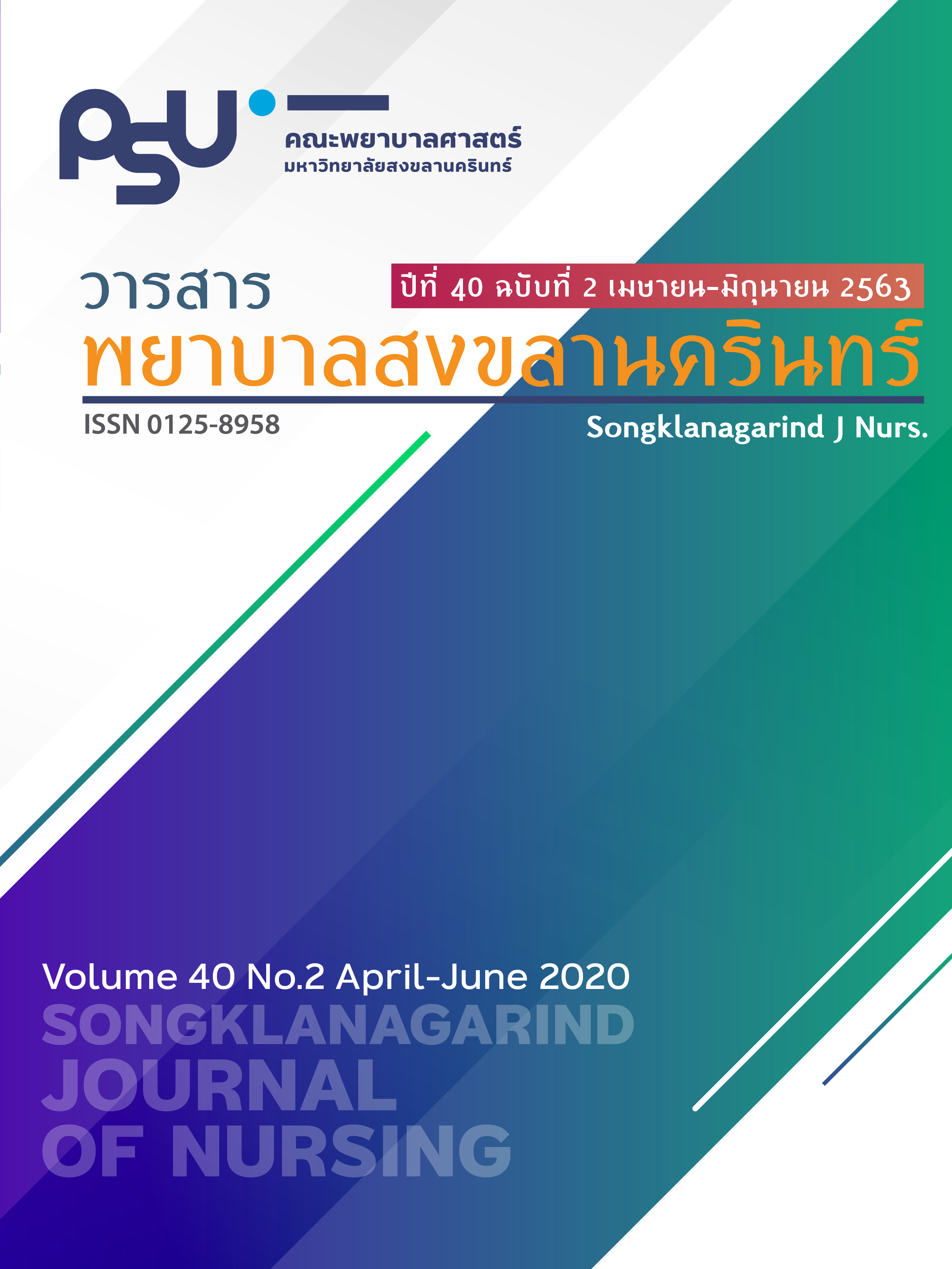Factors Predicting Overcrowding in Emergency Room of a University Hospital
Main Article Content
Abstract
The aim of this cross-sectional predictive study was to identify the predicted factors of emergency room (ER) overcrowding. The 4,039 patients who visited ER during March to May 2019 were selected. National Emergency Department Overcrowding Study (NEDOCS) was used to measure the degree of crowding. Every 4 hour, ER overcrowding was assessed by NEDOCS 273 times and patient’s information was retrieved from patient’s folder. Multiple logistic regression analysis was used to identify factors predicted ER overcrowding.
In conclusion according to research findings, decreasing waiting time of laboratory result report, decreasing boarding time in ER, and guideline or policy development may improve overcrowding in ER.
The research found that factors predicting ER overcrowding were number of patients who used ventilator (ORadj = 3.75, 95%CI: 2.19-6.44), number of patients who waited to be boarding from ER more than 2 hours (ORadj = 2.75, 95%CI: 1.15-6.55), number of patients who waited to triage (ORadj = 2.43, 95%CI: 1.82-3.24), number of patients who waited for laboratory result more than 2 hours (ORadj = 1.81, 95%CI: 1.38-2.38), number of patient in ER (ORadj = 1.79, 95%CI: 1.42-2.26), number of patients who waited to see doctor (ORadj = 1.48, 95%CI: 1.28-1.71), and number of doctors who delivered care in ER (ORadj = 1.45, 95%CI: 1.20-1.74)
Article Details
References
Ienghong K. Factors affecting length of stay more than 4 hours in the emergency department of Srinagarind hospital. Srinagarind Medical Journal. 2014; 29(1): 7-13. Thai.
Moore BJ, Stocks C, Owens PL. Trends in emergency department visits, 2006-2014. Agency for Healthcare Research and Quality; 2017; 1-20.
Department of Medical Services. Guideline for ER service delivery. Nontaburi: Academic office of Department of Medical Services; 2018. Thai.
Medical records and Statistic Department, Srinagarind Hospital. Emergency patient’s statistic of Srinagarind hospital, 2017. Khon Kaen. n.p. 2017. Thai.
Arkun A, Briggs WM, Patel S, et al. Emergency department crowding: factors influencing flow. West J Emerg Med. 2010; 11(1): 10-5.
O’Connor E, Gatien M, Weir C, et al. Evaluating the effect of emergency department crowding on triage destination. Int J Emerg Med. 2014; 7(1): 16.
Dadashzadeh A, Abdollahzadeh F, Vahdati SS, et al. Causes of delay in patient triage in the emergency departments of Tabriz hospital. Turk J Emerg Med. 2011; 11(3): 95-8.
Pascasie K, Mtshali NG. A descriptive analysis of emergency department overcrowding in a selected hospital in Kigali, Rwanda. Afr J Emerg Med. 2014; 4(4): 178-83.
Techaatik P, Sumritrin S, Sirithongsuk A, et al. Delay of accidental and emergency patient service. Thai Journal of Nursing and Midwifery Practice. 2017; 4(1): 25-35. Thai.
Doupe MB, Chateau D, Chochinov A, et al. Comparing the effect of throughput and output factors on emergency department crowding: a retrospective observational cohort study. Ann Emerg Med. 2018; 72(4): 410-9.
George F, Evridiki K. The effect of emergency department crowding on patient outcomes. Health Science Journal. 2015; 9(1): 1-6.
Khalifa M. Reducing emergency department crowding using health analytics methods: designing an evidence based decision algorithm. Procedia Computer Science. 2015; 63: 409-16.
Hong KJ, Shin SD, Song KJ, et al. Association between ED crowding and delay in resuscitation effort. Am J Emerg Med. 2013; 31(3): 509- 15. doi: 10.1016/j.ajem.2012.09.029.
Kulstad EB, Sikka R, Sweis RT, et al. ED overcrowding is associated with an increased frequency of medication errors. Am J Emerg Med. 2010; 28(3): 304-9.
Carter EJ, Pouch SM, Larson EL. The relationship between emergency department crowding and patient outcomes: a systematic review. J Nurs Scholarsh. 2014; 46(2): 106- 15.
van der Linden MC, Meester BE, van der Linden N. Emergency department crowding affects triage processes. Int Emerg Nurs. 2016; 29: 27-31.
Sun BC, Hsia RY, Weiss RE, et al. Effect of emergency department crowding on outcomes of admitted patients. Ann Emerg Med. 2013; 61(6): 605-11.
Asplin BR, Magid DJ, Rhodes KV, et al. A conceptual model of emergency department crowding. Ann Emerg Med. 2003; 42(2): 173-80.
Boyle A, Benuik K, Higginson I, et al. Emergency department crowding: time for interventions and policy evaluations. Emerg Med Int. 2012; 2012: 1-8. doi:10.1155/2012/838610.
Weiss SJ, Derlet R, Arndahl J, et al. Estimating the degree of emergency department overcrowding in academic medical centers: results of the National ED Overcrowding Study (NEDOCS). Acad Emerg Med. 2004; 11(1): 38-50.
Hoot NR, Zhou C, Jones I, et al. Measuring and forecasting emergency department crowding in real time. Ann Emerg Med. 2007; 49(6): 747-55.
Morley C, Unwin M, Peterson GM, et al. Emergency department crowding: A systematic review of causes, consequences and solutions. PLoS One. 2018; 13(8): 1-42.
Lartham K, Pearkao C. A study of quality of emergency patient triage at Srinagarind hospital. Paper presented at: The National and International Graduate Research Conference 2017. Proceeding of The National and International Graduate Research Conference; 2017 Mar 10; Khon Kaen, Thailand. Thai.
Saensom D. Respiratory system crisis and nursing care. In: Limumnoilap S, Tumnong C, editor. Critical Care Nursing. 7 th ed. Khon Kaen: Klungnana Printing Press; 2013. Thai.
Wibulpolprasert A, Sittichanbuncha Y, Sricharoen P, et al. Factors associated with overcrowded emergency rooms in Thailand: a medical school setting. Emerg Med Int. 2014: 1-4. doi: 10.1155/2014/576259.
Hoot NR, Aronsky D. Systematic review of emergency department crowding: causes, effects, and solutions. Ann Emerg Med. 2008; 52(2): 126-36.
Boyle A, Coleman J, Sultan Y, et al. Initial validation of the International Crowding Measure in Emergency Department (ICMED) to measure emergency department crowding. Emerg Med J. 2015; 32(2): 105-8.

